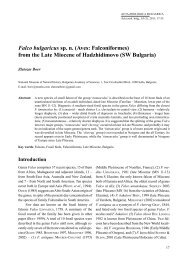Gyps bochenskii sp. n. (Aves: Falconiformes) from the Late ... - ecodb
Gyps bochenskii sp. n. (Aves: Falconiformes) from the Late ... - ecodb
Gyps bochenskii sp. n. (Aves: Falconiformes) from the Late ... - ecodb
Create successful ePaper yourself
Turn your PDF publications into a flip-book with our unique Google optimized e-Paper software.
18<br />
16<br />
14<br />
12<br />
10<br />
8<br />
b<br />
<strong>Gyps</strong> <strong>bochenskii</strong> <strong>sp</strong>. n. (<strong>Aves</strong>: <strong>Falconiformes</strong>) <strong>from</strong> <strong>the</strong> <strong>Late</strong>....<br />
<strong>Gyps</strong> <strong>bochenskii</strong> <strong>sp</strong>. n.<br />
Torgos tracheliotus<br />
Aegypius monachus<br />
<strong>Gyps</strong> fulvus<br />
<strong>Gyps</strong> bengalensis<br />
a<br />
<strong>Gyps</strong> <strong>bochenskii</strong> <strong>sp</strong>. n.<br />
<strong>Gyps</strong> africanus<br />
Torgos tracheliotus<br />
Aegypius monachus<br />
<strong>Gyps</strong> rueppellii<br />
<strong>Gyps</strong> fulvus<br />
<strong>Gyps</strong> bengalensis<br />
<strong>Gyps</strong> copro<strong>the</strong>res<br />
<strong>Gyps</strong> africanus<br />
Gypohierax<br />
<strong>Gyps</strong> rueppellii<br />
angolensis<br />
<strong>Gyps</strong> copro<strong>the</strong>res<br />
Gypaetus barbatus<br />
Gypohierax angolensis<br />
Gypaetus barbatus<br />
Haliaaetus albicilla<br />
Haliaaetus albicilla<br />
6<br />
15 20 25 30 35 40 45<br />
Fig. 7. Correlation between <strong>the</strong> height of <strong>the</strong> f. a. and <strong>the</strong> length of <strong>the</strong> phalanx dist. dig. I pedis [mm] (measurements<br />
‘b’ and ‘a’, Table 6) in <strong>the</strong> Old World vultures.<br />
tions. The diversification of <strong>Gyps</strong> vultures ‘...coincides<br />
with <strong>the</strong> diversification of Old World ungulates,<br />
e<strong>sp</strong>ecially in <strong>the</strong> family Bovidae and <strong>the</strong> expansion<br />
of <strong>the</strong> grass-dominated ecosystems (JOHNSON et al.<br />
2006). SEIBOLD, HELBIG (1995) state that four <strong>sp</strong>ecies<br />
of <strong>Gyps</strong> probably <strong>sp</strong>eciated even within <strong>the</strong><br />
Pleistocene.<br />
All <strong>the</strong> associated avifauna and <strong>the</strong> mammalian<br />
megafauna of <strong>the</strong> Villanyian of Varshets completely<br />
confirm <strong>the</strong> former existence of <strong>the</strong> open<br />
savannah-like grassland with scattered trees. The<br />
presence of <strong>the</strong> large griffon vultures among <strong>the</strong><br />
o<strong>the</strong>r forested-savanna components (Pachycrocuta<br />
perrieri, Vormela petenyii, Meles thorali, Lynx issiodorensis,<br />
Acinonyx pardinensis, Viretailurus schaubi,<br />
Croizetoceros ramosus medius, Eucladoceros<br />
senezensis, Gazello<strong>sp</strong>ira <strong>sp</strong>., Megalovis latifrons,<br />
Equus stenonis, etc., among <strong>the</strong> mammals, and Otis<br />
khosatzkii, Circaetus <strong>sp</strong>., Hieraaetus cf. fasciatus,<br />
Aquila <strong>sp</strong>. ex. gr. clanga, Melanocorypha <strong>sp</strong>.,<br />
Alauda <strong>sp</strong>. among <strong>the</strong> birds, as well as giant land<br />
tortoises) at Varshets resembles <strong>the</strong> associations<br />
<strong>from</strong> o<strong>the</strong>r Pliocene sites of <strong>the</strong> Old World. It is <strong>the</strong><br />
first site of this kind in <strong>the</strong> Balkans and completes<br />
our knowledge of <strong>Late</strong> Pliocene environment of this<br />
gateway to Europe.<br />
Metrical and e<strong>sp</strong>ecially morphological and proportional<br />
differences in all skeletal elements firmly<br />
exclude a taxonomic affinity with G. melitensis or<br />
G. fulvus.<br />
Varshets is <strong>the</strong> first known and <strong>the</strong> earliest<br />
Pliocene (and Tertiary) site in <strong>the</strong> Palearctic region<br />
with <strong>the</strong> genus <strong>Gyps</strong>. In <strong>sp</strong>ite of <strong>the</strong> sou<strong>the</strong>rn origins<br />
of <strong>the</strong> genus, it is clear that at <strong>the</strong> very end of<br />
<strong>the</strong> Tertiary its representatives were found in <strong>the</strong> SE<br />
European area (Balkans). As has been shown <strong>from</strong><br />
<strong>the</strong> observations on recent griffons vultures (Gir<br />
Forest, India; GRUBTH 1978) strong dietary competition<br />
exists among coexisting <strong>sp</strong>ecies (G. bengalensis,<br />
G. indicus (incl. G. tenuirostris – Z. B./)) and G. fulvus).<br />
The last <strong>sp</strong>ecies clearly dominated, in <strong>sp</strong>ite of<br />
its ca. 10 times lower numbers. This supports <strong>the</strong> suggestion<br />
on morphological and ecological adaptations<br />
of G. fulvus lineage of griffons. Although of o<strong>the</strong>r<br />
237





